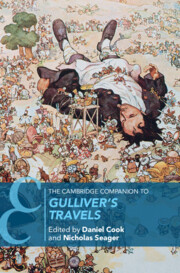Book contents
- The Cambridge Companion to Gulliver’s Travels
- The Cambridge Companion to Gulliver’s Travels
- Copyright page
- Contents
- Figures
- Notes on Contributors
- Abbreviations
- Note on the Text
- Chronology
- Introduction
- Part I Contexts
- Chapter 1 Politics
- Chapter 2 Religion
- Chapter 3 Bodies and Gender
- Chapter 4 Science, Empire, and Observation
- Part II Genres
- Part III Reading Gulliver’s Travels
- Part IV Afterlives
- Further Reading
- Index
- Cambridge Companions to Literature
Chapter 2 - Religion
from Part I - Contexts
Published online by Cambridge University Press: 05 October 2023
- The Cambridge Companion to Gulliver’s Travels
- The Cambridge Companion to Gulliver’s Travels
- Copyright page
- Contents
- Figures
- Notes on Contributors
- Abbreviations
- Note on the Text
- Chronology
- Introduction
- Part I Contexts
- Chapter 1 Politics
- Chapter 2 Religion
- Chapter 3 Bodies and Gender
- Chapter 4 Science, Empire, and Observation
- Part II Genres
- Part III Reading Gulliver’s Travels
- Part IV Afterlives
- Further Reading
- Index
- Cambridge Companions to Literature
Summary
Jonathan Swift was a High Church clergyman and Dean of St Patrick’s Cathedral in the established (Anglican) Church of Ireland. However, Gulliver displays no Christian devotion. His Christianity is simply assumed in a narrative which presupposes a largely Christian readership. The chapter considers Gulliver’s witness of religious practices in the countries he visits. Gulliver’s Travels is predominantly a secular book, but its philosophical, political, and historical perspectives are refracted through the lens of Swift’s religious confession. In these voyages to remote nations of the world, Gulliver encounters or discusses religio-political issues that were highly controversial back home in Gulliver’s England. The book draws upon religious history and polemic. The satire’s treatment of European religious controversy and its view of human nature attracted charges of blasphemy and irreligion, as had Swift’s earlier satiric masterpiece A Tale of a Tub.The chapter examines these charges and comments on some modern critical views of the religious implications of Gulliver’s Travels. It indicates some significant parallels between Swift’s Houyhnhnms and Thomas More’s Utopians.
- Type
- Chapter
- Information
- The Cambridge Companion to Gulliver's Travels , pp. 23 - 33Publisher: Cambridge University PressPrint publication year: 2023

